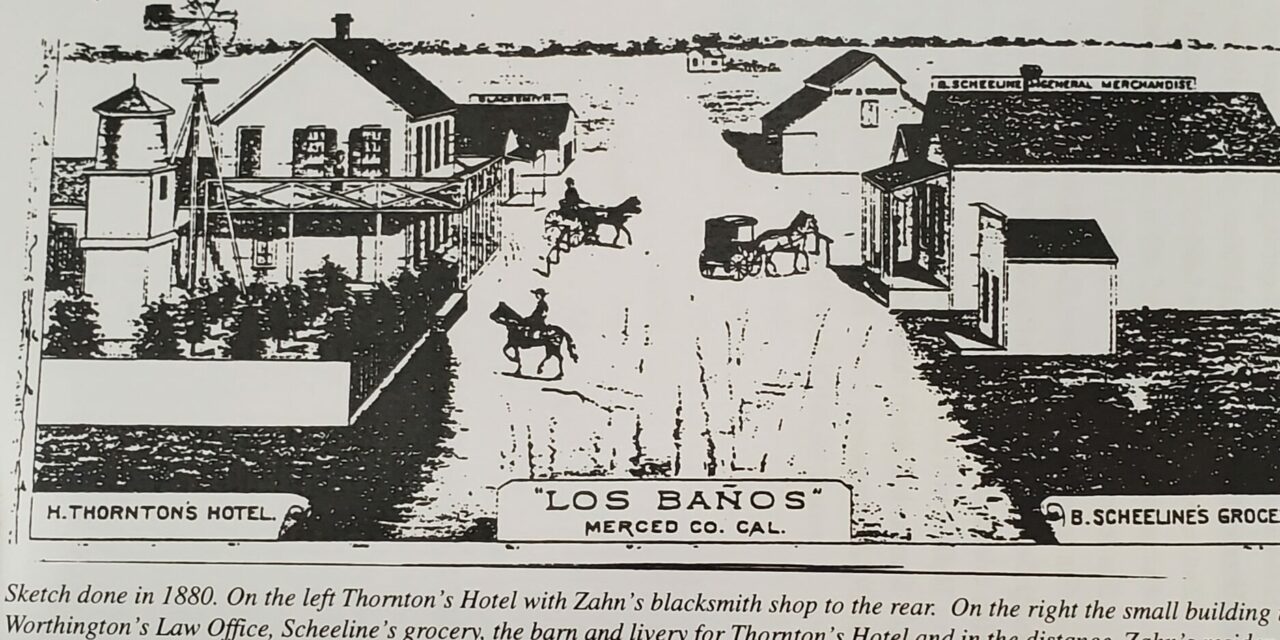The settlement of Los Banos was initially located several miles west of its current location. Early stage-stop communities acted as the region’s sources of supplies, services and sense of community for the new settlers in the region. This article summarizes the history of a few early communities that are long abandoned but colorful components to the history of the westside.
In our last article, we covered the first settlers on the west side, The Woods brothers. They initiated a stream of pioneers searching for cheap land and a fresh start in the early 1860s. Land that wasn’t covered by Mexican land grants was owned by the government and was for sale at $1.25 / acre. It was so plentiful that most of the early settlers didn’t bother buying the land, they simply squatted.
Los Banos Roots
Supplies were at a premium. All supplies, including building lumber, had to be imported over Pacheco Pass or from Stockton. Early settler brothers Uriah and Davie Wood were successful in convincing Gustav Kreyenhagen and his family to relocate from San Francisco to the west side to open a supply store in 1865. Kreyenhagen’s first venture was at the then somewhat abandoned Lone Willow Stage station, which at its heyday was a station for the Butterfield Overland Stage from 1858 to 1860, located on what is now Delta Road, 1.5 miles north of Highway 152 and is commemorated by a Native Son’s marker. The Kreyenhagens were at this site for a little over a year, then moved a couple of miles to the east where the Pacheco Pass stage road intersected the Stockton/Visalia stage road, located on what is now Turner Island Road, 1.5 miles north of highway 152. This only lasted a couple of years when Henry Miller relocated Kreyenhagen’s store several miles west in 1870, about 0.2 miles west of what is now Volta Road and 1.3 miles north of Highway 152.
Kreyenhagen’s store was successful. A blacksmith shop, hotel, saloon and jailhouse were later added, forming a small community. The early settlers had to rely on mail being brought from Gilroy. The mail would be retrieved to Kreyenhagen’s store where he divvied it out in converted chicken coop stalls. In 1872, a man named Korn purchased Kreyenhagen’s store and, in 1873, a U.S Post Office was established there. The federal government named the post office Los Banos after the nearby Los Banos Creek, marking the first time the name Los Banos was used for anything other than the creek. From then on, the small community became known as Los Banos. Another hotel was constructed in 1872 by Adolph Widman about a third of a mile northwest of Old Los Banos. This hotel attracted sheepherders in the region and their dogs, so it became known as “Dogtown”. The Widman hotel is still standing today as a private residence and is located on what is now Volta Road, 1 mile north of Highway 152.
Center Point
Meanwhile, another little community was developing on the west side. Anton Pfitzer moved his house and blacksmith shop from a location on Los Banos Creek to where Ortigalita Road and Highway 152 now intersect. This location was at the crossroads of the two major stage lines in the region: the Visalia/Gilroy stage road and the Visalia/Stockton stage line. In 1871, Nicholas Bibby sold his blacksmith shop in old Los Banos and bought out Pfitzer. Due to its crossroad location, Bibby named the community Center Point. The pioneer village consisted of a blacksmith shop, a store, a country boarding house named Bachelor’s Inn, a China Wash House, a saloon and a schoolhouse. In 1876, a U.S Post Office was established at the store. But when it came to giving the name Center Point to the new Post Office, the government agents balked. They claimed that Center Point was ungrammatical and that the name should be Central Point, so Central Point it became.
Coming of the Railroad and “New” Los Banos
In late 1889, the Southern Pacific Railroad bypassed the old stage communities and went through the current site of Los Banos. All the old stage communities were relocated to sites along the railroad, and Old Los Banos and Center Point were no exception. The stores, hotels, blacksmith shops and buildings were either moved to the site where “New” Los Banos was being constructed or were simply abandoned and faded away.
The old stage towns of Old Los Banos and Center Point belong to the past; a bygone era of the development of the region and a part of the colorful history of the Westside.
Information for this article was from the Ralph Milliken oral interviews at the Milliken Museum, the “Road Over”, edited by Charles Sawyers and “Dogtown & Ditches” by Wayne Pimentel. For more information on Old Los Banos, Center Point and the Greater Westside, visit the Milliken Museum in Los Banos, open every day except Mondays, from 1 to 4 p.m.




